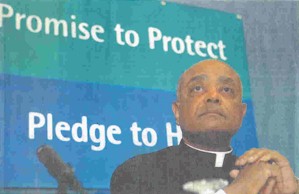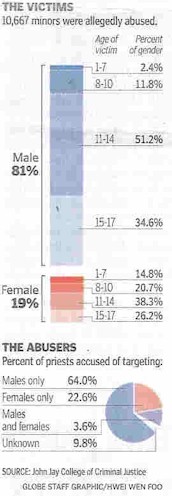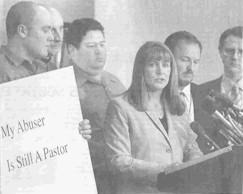By Kevin Cullen
Boston Globe
February 28, 2004
http://www.boston.com/globe/spotlight/abuse/stories5/022804_victims.htm
[See also a set of graphs and tables summarizing the findings of the National Review Board Report {1} {2} {3}and the accompanying article by Michael Paulson.]
Washington -- More than 80 percent of minors under the age of 18 who were sexually abused by Roman Catholic priests in the United States since 1950 were male, a report released yesterday found, raising questions about what role homosexuality played in the crisis and whether the Catholic Church will try to limit or prevent gay men from joining the priesthood.
 |
| "The terrible history recorded here is history," said Bishop Wilton D. Gregory of a report on clergy abuse released yesterday. |
Neither homosexual priests nor celibacy were root causes of the clergy sexual abuse crisis, said Robert S. Bennett, the Washington lawyer who headed the research committee of the National Review Board that prepared a report detailing the "causes and context" of the crisis. But, he added, "an understanding of the crisis is not possible without reference to these issues."
 |
Bennett said there were "two overarching contributing factors" to why so many priests abused minors: Dioceses and orders did not screen candidates for the priesthood properly, allowing many sexually dysfunctional and "immature" men into seminaries; and seminaries did not adequately prepare students for the priesthood, particularly for the challenge of remaining celibate.
"There are no doubt many outstanding priests of a homosexual orientation who live chaste, celibate lives, but any evaluation of the causes and context of the current crisis must be cognizant of the fact that more than 80 percent of the abuse at issue was of a homosexual nature," Bennett said.
 |
| Barbara Blaine, president of the Survivors Network of Those Abused by Priests, addressed reporters yesterday in Washington, D.C., prior to the release of the report on priest sex abuse. She was surrounded by alleged victims and group board members. |
Members of the team of academic researchers from the John Jay College of Criminal Justice that compiled a second report, a quantitative study on the nature and scope of the abuse, said there is no clinical evidence suggesting that homosexuals are more likely to have sex with minors than heterosexuals, and Bennett stressed that more research is needed before conclusions can be drawn about the role homosexuality played in the crisis.
As a footnote to the report explained, the report did not address "the characteristics of the abuser, such as sexual orientation, sexual continence, religious fidelity, and the like."
"Only a population-based interview survey contrasting offending priests against nonoffenders can fully address these aspects of the problem," it said.
Bennett's review board report recommended such a study.
Speaking at a press conference after the report's release, Archbishop Timothy M. Dolan of Milwaukee, former rector of the North American College and an influential figure in the area of training for the priesthood, responded to a question by saying that seminaries already scrutinize gay applicants more closely than heterosexuals.
Bishop Wilton D. Gregory, president of the US Conference of Catholic Bishops, added that the church "should not focus on any one area" when screening applicants.
The Vatican, however, is discussing the possibility of banning homosexuals from joining the priesthood, a scenario Gregory said "needs further discussion."
Those who attribute much of the scandal to a disproportionate number of homosexual priests pointed to the report's findings as validation of their views.
"This is absolute confirmation that homosexual predators were the main perpetrators in this scandal," said Deal Hudson, the editor of Crisis, a conservative Catholic journal, who has accused church leaders of ducking the issue because it is controversial.
But Matthew J. Gallagher, executive director of Dignity USA, a group of gay and lesbian Catholics, accused the church leadership, in its interpretation of the report, of trying to make gay priests the scapegoats for the crisis. Gallagher said the statistics indicate the abuse was about access to victims, not the sexual orientation of the abusers.
"They abused mostly boys because they didn't have as much access to girls," he said.
Gallagher accused the bishops of trying to "deflect attention away from their own failings."
Many victims' advocates have questioned the role of homosexuality in the crisis, saying that there is no objective data to prove a connection and that it diverts attention from the failure of bishops to root out abusive priests.
Barbara Blaine, president of the Survivors Network of those Abused by Priests, said yesterday's report revived what she called "an old myth, that gay priests are responsible for the scandal."
"There's just too little evidence to make this conclusion," said Blaine, adding that half of her group's 4,600 members are female. "Some argue many boys were victimized because abusive priests had greater access to them."
The report found that 4,392 priests had been accused of sexually abusing minors between 1950 and 2002, or about 4 percent of the 109,694 priests in active ministry during that period. Of the 10,667 reported victims, 81 percent were male, the report said, and more than three-quarters of the victims were postpubescent, meaning the abuse did not meet the clinical definition of pedophilia.
Instead, most fell victim to ephebophiles, men who are sexually attracted to adolescent or postpubescent children.
Karen Terry, the principal investigator for the team of academics from John Jay College of Criminal Justice that carried out the research in the other quantitative report, said the average age of victims was 12.6 years, but the most common category of victims was a boy between 11 and 14. That category accounted for 40 percent of all victims, she said.
The report found that 51 percent of victims, including females, were between 11 and 14; 27 percent were between 15 and 17; 16 percent were from 8 to 10; and nearly 6 percent were under 7. Male victims tended to be older than female victims, Terry said.
The only age group in which girls accounted for more victims than boys was ages 1 to 7, when they made up 58 percent of victims. In the 8-to-10 age group, boys made up 71 percent of victims. Boys accounted for 85 percent of victims in both the 11-to-14 and 15-to-17 age categories. The report found that 3.6 percent of abusive priests abused both boys and girls of all ages, while 22.6 percent abused only females and 64 percent abused only males. In nearly 10 percent of the reported cases, the gender of the victim was unknown.
Terry said the abuse peaked in 1970, and data compiled for the report indicate that between 1970 and 1979 there were more than five times as many male victims as female victims. In the 1960s and 1980s, there were three to four times more male victims than female victims. The gender gap was narrower in both the 1950s and 1990s. Critics, including Hudson, who blame homosexuals for most of the problem, say there was an influx of gay priests in the 1960s and 1970s, but it is unknown how many priests were gay.
Louis Schlesinger, a professor of psychology at John Jay College who was on the research team, cautioned against reading too much into the gender figures when assessing the causes of the crisis. He said there was no evidence supporting theories that homosexuals are more likely to have sex with minors.
"Fifty percent of pedophiles are married," he said.
Original material copyright © BishopAccountability.org 2004. Reproduce freely with attribution.